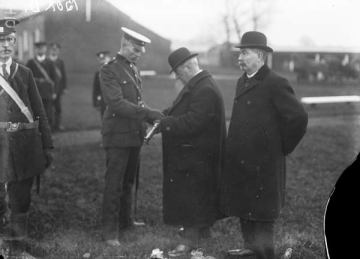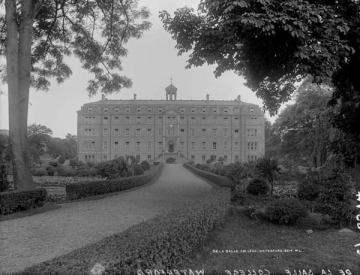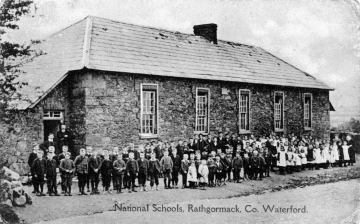Politics and institutions in Waterford in the early 20th century
View the photo galleryThe politics of Waterford were dominated by John Redmond, who was MP for Waterford between 1891 and 1917. After 1900 Redmond was the undisputed leader of nationalist Ireland and was one of the most influential Irish leaders in a long time. Redmond was elected MP for Waterford city in the year of the death of Parnell. Originally the MP for neighbouring Wexford, he won the Waterford city seat in a by-election in 1891, following the death of the Parnellite MP, Richard Power. In taking the seat he saw off the challenge of Michael Davitt, founder of the Land League but an anti-Parnellite despite his radical background.
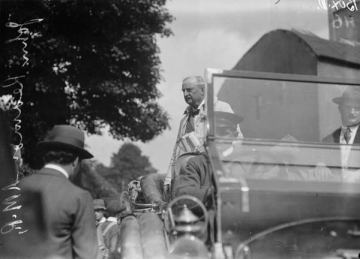
John Redmond MP, the leading champion of Irish home rule, addresses a group from the back seat of a car, 1912. The 3rd Home Rule bill was passed by House of Commons in 1914, but never implemented.
(NLI, IND H 0006)
Redmond subsequently held the seat in the 1892 General Election, beating off the challenge of David Sheehy, future MP for Meath South and father of Hannah Sheehy Skeffington, feminist and wife of Frank (see Hannah returned as Emily, and both refusing information about religion). Another daughter of David Sheehy was Mary Sheehy, wife of prominent young Home Rule MP Tom Kettle who was killed on the Somme in 1916. Redmond’s victory marked only one of a handful of victories by a Parnell loyalist in that election, and by 1900 Redmond had emerged as a compromise and unity candidate for the leadership of a united Irish Party in the House of Commons, ahead of such grandees as John Dillon
In the heyday of his leadership, Redmond seemed to have achieved what Parnell had failed to do when he secured the passing of the 3rd Home Rule bill in 1914. By then, however, resistance by Ulster loyalists, with the support of British conservatives, had already cast a shadow over Redmond’s achievement. His refusal to countenance anything but temporary partition, his decision to support the British war effort during the Great War and his failure to have Home Rule implemented on satisfactory terms during the course of the war, fatally undermined his movement. In 1917, his brother Willie died on the Western Front in Belgium. Many Waterford men lost their lives during the Great War, including Private Maurice Duggan of Kilduanewho enlisted at 17 and died aged 19 at the Battle of Messines in June 1917. When it was clear that Redmond’s last attempt to secure a satisfactory Home Rule agreement had failed in 1917, he passed away exhausted. Yet even in the 1918 General Election, which saw the decimation of the old Home Rule party, Waterford City returned his son, William Archer Redmond, as MP. It did so again in the 1920s when he was elected as an independent nationalist TD to Dáil Èireann.
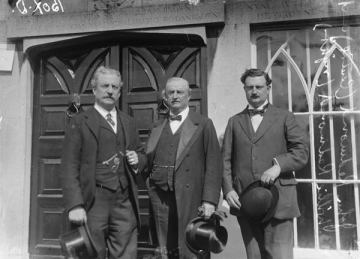
John and William Redmond, photographed in 1912. William would die on the Western Front during the First World War.
(NLI, IND H 0003)
One of John Redmond’s successors as MP for Waterford was the Republican, Cathal Brugha (see return for Cabra Rd., Dublin, filled out in Irish, who had been elected in the 1918 General Election. Brugha was a Dubliner who became chief of the staff of the Irish Republican Army. After his death in the civil war in 1922, his wife Caitlín was elected as a TD to Dáil Èireann. Overall, there was a strong republican tradition in the county. Thomas F. Meagher, credited with introducing the tricolour to Ireland in 1848, was from Waterford. Denis B. Cashman, from Dungarvan, was a member of the Irish Republican Brotherhood who was sentenced to seven years penal servitude in Australia. He later settled in America, writing a biography of Michael Davitt, and his Fenian diary was later published. Men such as P.C. O’Mahoney and George Lennon from Dungarvan led the fight in Waterford against British rule during the War of Independence.
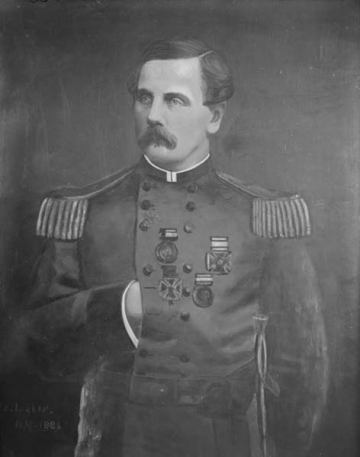
A Poole photograph of the famous 19th century fenian, Thomas Francis Meagher, the Waterford man credited with introducing the tricolour to Ireland in 1848.
(NLI, P WP 0165)
There was also a strong element within Waterford which professed its allegiance to the British crown. Much of this was centred on the landed aristocracy, including the Marquis of Waterford. The extraordinary census return for the Marquis of Waterford documents the extent of his household near Carrick-on-Suir. Visiting on census night was the Marquis of Lansdowne with attendant servants. The daughter of the Marquis of Waterford, Lady Clodagh Anson, who lived near Lismore, had a similarly well-equipped household, and gives her occupation as “The Lady Clodagh”.
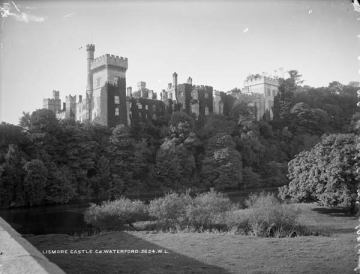
Lismore Castle, Co. Waterford ca. 1900. Boasting spectacular views over the Blackwater Valley, the Castle has been the Irish home to the Dukes of Devonshire since 1753.
(NLI, LROY 03624)
Local government flourished in Waterford after the 1898 Local Government Act. Michael Byrne was a member of Dungarvan Urban District Council between 1908 and 1918. After his death a memorial plaque was erected on the Town Hall in honour of the work he did to promote the conditions in which the inmates of the various institutions under the control of the Board of Guardians were housed. This included the inmates of the Waterford Lunatic Asylum at John’s Hill in Waterford city, and the workhouse in Kilmacthomas.
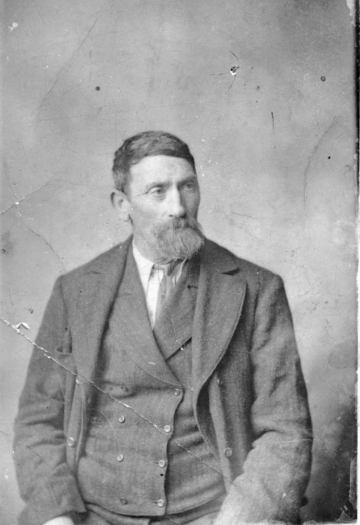
A portrait of Councillor Michael Byrne. A member of the Dungarvan Urban District Council from 1908 to 1918 and the Workhouse Board of Guardians, 1913-1917.
(Waterford County Museum, EK 135)
Although Waterford was largely Catholic, various other religions were found. Waterford county was 95.7% Catholic and the city was 92.2% Catholic. There was also a sizeable Protestant community (see Isabel Atkinson of Dunmore), which included a Church of Ireland Dean (Henry Brougham of Lismore). There were prominent Quaker families (see Isaac Bell of Coal Quay), and there was also a Jewish family, the Osiakowskis of Scotch Quay, born in what they described as ‘Russian Poland’. There was a lady’s maid living in Tramore who had been born in Lorraine in France and who gave her religion as ‘Église Suisse’. There were others who refused to answer the question, including a group of Scandinavian sailors and some English mechanical engineers staying above a public house on Merchant’s Quay.
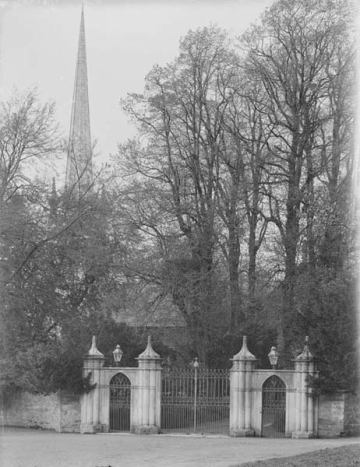
The entrance to the Protestant Church in Lismore, Co. Waterford ca. 1900. In 1911, Protestants accounted for less than 4% of the county´s population.
(NLI, P WP 0456)
Religion inevitably impacted on education. There was a boarding school on Dunmore Road in Waterford City which was run by Quakers. As well as Quakers, the students in the school were Methodist and Church of Ireland. Many had been born in the counties of Munster, but others were born as far away as Madagascar, South Africa and Germany. The Waterford Academy of Music had professors such as John Storer, who lived at Custom House Quay, and Thomas Threlfall who lived on Parade Quay. The only Irish scientist to win a Nobel Prize was born in Waterford. Ernest Walton left the county to move with his Methodist father to Tyrone when he was just 9 and he later received his award for his work in helping to split the atom.
On a more prosaic level, the National School system (see return for Acsah Crampton, National School teacher in Tramore ensured that all but 15.9% of the population of Waterford could read and write. This was a significant improvement from the 1891 figure of 26.8%. There were still many who were illiterate, however (see William Esmonde of Ballycarnane). Illiteracy levels were slightly lower in the city than in the rest of the county.
There were also educational advances in Irish. The collapse in the numbers of people speaking Irish in the second half of the nineteenth century left concentrations of Irish speakers in Gaeltacht areas along the west coast of Ireland. The exception to this was the Ring Gaeltacht in Waterford, concentrated on the parish of Ring, which was situated on the southern shore of Dungarvan Bay. The majority of the census forms for this area were returned in Irish, unsurprisingly including that of the local Gaelic League organiser Pádraig Ó Cadhla A bilingual programme for Ring school had been introduced in January 1908. A year previously national school inspectors had noted that 90% of students in the area spoke Irish in their homes.

